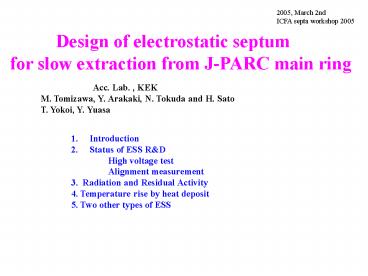Design of electrostatic septum - PowerPoint PPT Presentation
1 / 20
Title:
Design of electrostatic septum
Description:
Design of electrostatic septum – PowerPoint PPT presentation
Number of Views:54
Avg rating:3.0/5.0
Title: Design of electrostatic septum
1
2005, March 2nd ICFA septa workshop 2005
Design of electrostatic septum for
slow extraction from J-PARC main ring
Acc. Lab. , KEK M.
Tomizawa, Y. Arakaki, N. Tokuda and H. SatoT.
Yokoi, Y. Yuasa
- Introduction
- Status of ESS RD
- High voltage test Alignment measurement
- 3. Radiation and Residual Activity
- 4. Temperature rise by heat deposit
- 5. Two other types of ESS
2
J-PARC Main Ring
- 3.3x1014 protons per pulse(15mA) full beam power
750kW _at_50GeV - ? beam loss as possible as small lt1 (7.5kW)
level radiation safety problem
3
psext4_007.dat mad332.madenv4.com
4
Parameters of Electrostatic septa (reference
design) thickness
voltage(kV) L kick angle
(mm) /gap(mm) (m)
(mrad) ESS1W/Re(3) wires 8020
170/25 1.5
-0.2 ESS2W/Re(3) wires 8020
170/25 1.5 -0.2
5
50GeV primary beam hit rate on ESS wires
dynamic bump
beam hit rate on ESS wires
tri0103_090 (sca0122_2_044)
tri0103_095
w100mm, L1.5m
before 3turns
extraction
Qv20.775
min. hit rate 0.8 _at_100mm min. hit rate 0.5
_at_50mm
Circulating Beam Parameters ex6.1p mm?mrad
ey6.1p mm?mradDp/p0.25
6
Protons scattered on the ESS wires (MARS)
40cm downstream from ESS1 exit
(Reference ESS design)
sadin_foilsct_case1.dat r12_case1.com
Scattered to circulating side
Scattered to extracted side
Low Density Bulk Model
Hit rate 0.01 (1), full beam 750kW real loss
rate N(hit)-N(scatt.)/N(hit) real loss
750kW x0.01 x 0.0770.58kW
7
RD electrostatic septum
80mm W/Re(3) wires, 1.25mm space, h80mm
8
High Voltage Test of RD electrostatic septum
GOAL 170kV/25mm gap, 6.8MV/m SUS cathode
small discharge _at_170kV --gt conditioning at
higher voltage ceramic feedthrough was broken
_at_237kV Ceramic A-479(99)-gtKP-999(99.9)
alumina content Still small discharge _at_170kV
--gt conditioning at higher voltage A wire was
cut by damage due to high dark current(200mA)
conditioning at 235kV without wires --gt very
stable Ti electrode(10nm oxidized film on
surface----suppress e emission) wires were
replaced to new ones --gt170kV/25mm operation is
stable!!
9
careful conditioning not to makes any serious
damage Automatic high voltage conditioning by PC
0.12kV/5min
10
Alignment Errors of Wires
Laser focus displacement meter
11
Short Test Piece
Prototype
Damage of wires Guide groove
12
Residual Activity of Ti ESS chamber
30days irradiation Unit mSv/h 1 -gt 30 day cooling
13-gt1.6
5.2-gt0.7
up
down
ESS chamber sideESS chamber endESS downstream
14-gt1.8
5.7-gt0.7
4.0-gt0.5
8.4-gt1.1
left
wires
right
7.7-gt1.0
21-gt2.7
Ti Flange 59.9-gt7.5Ti Duct 94.8-gt11.9
upstream
downstream
1day cooling
30days cooling
13
Absorbed dose of QFP coil insulation (polymid)
1 year operation (5000h)wires hit rate 1 of
750kW
Polimid 400MGy ---gt Life gt10 years
14
Residual Activity of Quadrupole (QFP)
30days irradiation Unit mSv/h 1 -gt 30 day cooling
QFP upstream
QFP side view
3.2-gt0.7
11-gt2.5
8.8-gt1.9
15-gt3.3
9.4-gt2.1
6.7-gt1.5
15
Temperature rise by energy deposition in
Tungsten wires
Cooled by thermal radiation (Cooling by
conduction can be neglected)
EesT4 s Stefan Constante emissivity
e0.1
Initial temperature 30oC repetition period
3.6s Flat top time 0.7s proton number
3.3x1014ppp x 0.01 proton dE/dx 5.72x10-12
J/cm Next Step dE/dx by MARS Measurement of e
by heat load in the vacuum
e1.0
16
Ribbon foils (AGS type) ESS1 W, 30mm20mm, 1mm,
4mm spacing, L1.5m, 0.2mrad ESS2 W, 30mm20mm,
1mm, 4mm spacing, L1.5m, 0.2mrad
ESS2
ESS1
Thinner reduce hit rate Mechanically stronger
reliable Smaller deviation due to electric filed
17
Alignment Errors of Ribbon Foils
Tension 2kg
18
Scattererribbon ESS Scatterer 30mm20mm, 1mm,
40mm spacing, L0.5m, 0mrad ESS1 W, 30mm20mm,
1mm, 4mm spacing, L1.0m, 0.133mrad ESS2 W,
30mm20mm, 1mm, 4mm spacing, L2.0m, 0.267mrad
ESS2
ESS1
scatterer
Scatterer low average mass density, no electric
field Beam hits scatterer Multiple scattering is
dominant process--gt radiation is reduced Beam
hit rate on downstream ESS foils is small
Needs more space to get same kick angle
19
Beam Loss Performance of three types
hit rate at wires or ribbons Scattering
process by MARS (low density bulk model) Track
scattered protons check apertures of other all
septa and ducts circulated protons survived
protons at exit of the ring
real loss extraction
in the whole ring efficiency 8020mm wires
1.88kW 99.75 3020mm ribbons
1.05kW 99.86scattererribbons
0.71kW 99.91
Low density bulk model is realistic ?
20
Production of Slow Extraction Devices will
start from spring 2006. We have one more year
to fix ESS scheme! Scattering simulations
RD ESS (alignment and high voltage
test) establish maintenance scenario under
high residual activity high voltage
cable vacuum flange ESS chamber
install/uninstall by Air palette fluorinert
exchange/circulation































